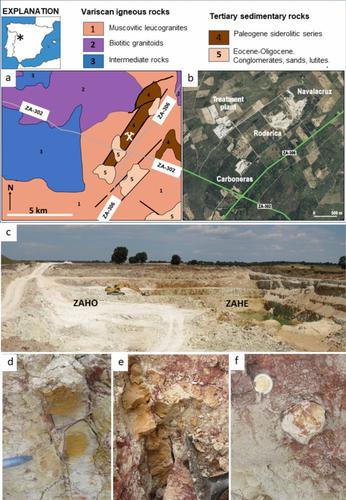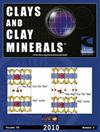The Kaolin and Bentonite Deposit of Tamame De Sayago (Zamora, Spain): Mineralogy, Geochemistry, and Genesis
IF 2.1
4区 地球科学
Q4 CHEMISTRY, PHYSICAL
引用次数: 0
Abstract
Abstract A geological, mineralogical, and geochemical characterization of the Tamame de Sayago (Zamora, Spain) deposit was carried out with the aim of knowing the conditions that facilitated the genesis in the same deposit of kaolinite and smectites. The alteration processes affecting a Variscan granite were deduced throughout the study of a very wide group of representative samples by X-ray diffraction (XRD), scanning electron microscopy (SEM), chemical analyses of major, minor, and trace elements, as well as δ 18 O, δ 34 S stable isotope and K/Ar dating analyses. In addition, 2D and 2.5D graphs of the kaolinite and smectite isoconcentrations were obtained from core data. According to the color and texture, two different clayey rock types were identified and named as homogeneous alteration zones (ZAHO) and heterogeneous alteration zones (ZAHE). The ZAHO are regoliths in which the granite texture is preserved, and the feldspars are almost completely kaolinized. In the ZAHE, the original texture of the granitic rock is lost, and the main clay mineral is smectite. The mineralogical composition is similar, with kaolinite, smectite, mica, quartz, scarce feldspar, and occasionally natroalunite and APS (aluminum-phosphate-sulphate); however, the mineral concentration varies considerably because ZAHO are rich in kaolin areas whereas ZAHE are bentonitic areas. Both rock types contain numerous veins and nodules. The weathering of the Paleozoic granite alongside the absence of sedimentation during the Mesozoic led to the formation of kaolinite that is preserved in ZAHO materials. Nonetheless, during the Cretaceous–Tertiary transit, the conditions of tectonic stability varied. Late Variscan faults reactivated which allowed the percolation of Mg- and Ca-rich hydrothermal fluids through the already kaolinized granite, increasing the alteration of the primary silicates and leading to the formation of smectites in ZAHE materials. The amount of smectites is greater closer to the faults. The stable isotopes indicate the meteoric nature of the low-temperature hydrothermal fluids. The K/Ar data obtained from the natroalunite of veins indicate that those hydrothermal fluids circulated in different pulses from 66.4 ± 1.7 to 58.8 ± 1.5 Ma, as a minimum. Those ages are coincident with the first formation stages of the Duero Basin.

西班牙萨莫拉Tamame De Sayago高岭土和膨润土矿床:矿物学、地球化学和成因
摘要对西班牙萨莫拉(Zamora)的Tamame de Sayago矿床进行了地质、矿物学和地球化学表征,目的是了解促进同一高岭石和蒙脱石矿床成因的条件。通过x射线衍射(XRD)、扫描电镜(SEM)、主、次、微量元素化学分析、δ 18o、δ 34s稳定同位素和K/Ar定年分析,推断了影响瓦里斯坎花岗岩的蚀变过程。此外,从岩心数据中获得了高岭石和蒙脱石等浓度的2D和2.5D图。根据颜色和质地,识别出两种不同类型的粘土岩,并将其命名为均质蚀变带(ZAHO)和非均质蚀变带(ZAHE)。ZAHO是保存花岗岩结构的风化岩,长石几乎完全高岭土化。在ZAHE中,花岗岩的原始纹理丢失,主要粘土矿物为蒙脱石。矿物组成相似,有高岭石、蒙脱石、云母、石英、稀有长石,偶有钠矾石和APS(磷酸铝硫酸盐);然而,由于ZAHO富含高岭土区,而ZAHO是膨润土区,因此矿物浓度差异很大。两种岩石类型都含有大量的矿脉和结核。古生代花岗岩的风化作用以及中生代沉积的缺失导致了高岭石的形成,这些高岭石被保存在ZAHO材料中。然而,在白垩纪-第三纪过渡期间,构造稳定性条件发生了变化。晚瓦立斯坎断裂的重新激活使得富镁、富钙热液通过高岭土化的花岗岩渗透,增加了原生硅酸盐的蚀变,导致了扎和物质中蒙脱石的形成。靠近断层的蒙脱石含量较多。稳定同位素反映了低温热液的气象性质。矿脉钠矾石的K/Ar值表明,这些热液流体以不同脉冲循环,最小值为66.4±1.7 ~ 58.8±1.5 Ma。这些年龄与Duero盆地的第一形成阶段一致。
本文章由计算机程序翻译,如有差异,请以英文原文为准。
求助全文
约1分钟内获得全文
求助全文
来源期刊

Clays and Clay Minerals
地学-地球科学综合
CiteScore
3.40
自引率
9.10%
发文量
46
审稿时长
3 months
期刊介绍:
Clays and Clay Minerals aims to present the latest advances in research and technology concerning clays and other fine-grained minerals, including but not limited to areas in agronomy, ceramics, colloid chemistry, crystallography, environmental science, foundry engineering, geochemistry, geology, medicinal chemistry, mineralogy, nanoscience, petroleum engineering, physical chemistry, sedimentology, soil mechanics, and soil science. Clays and Clay Minerals exists to disseminate to its worldwide readership the most recent developments in all of these aspects of clay materials. Manuscripts are welcome from all countries.
 求助内容:
求助内容: 应助结果提醒方式:
应助结果提醒方式:


